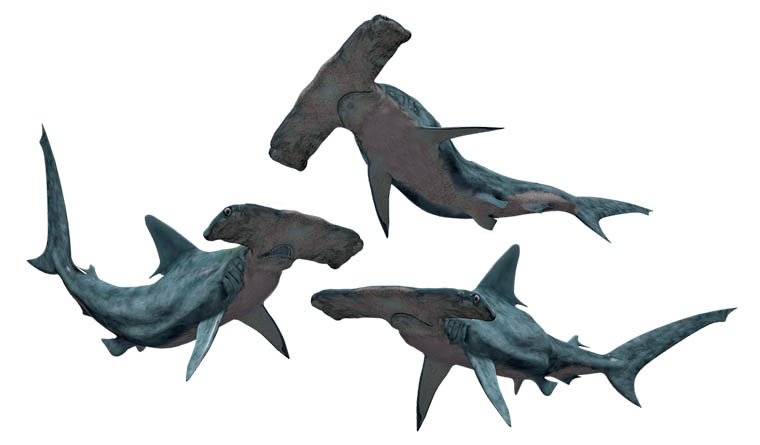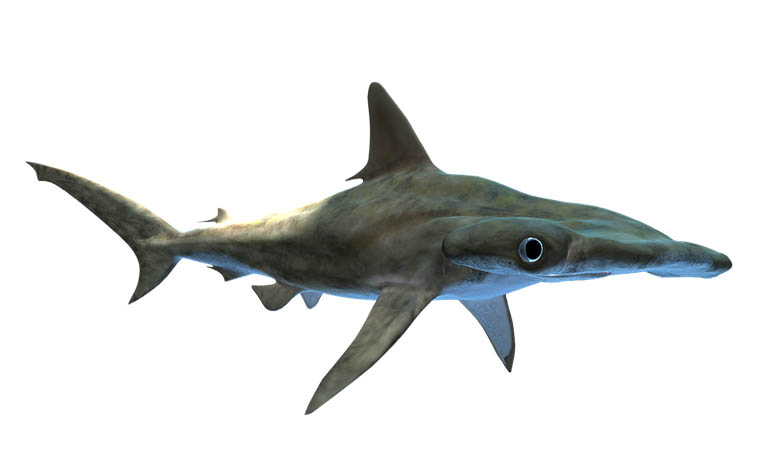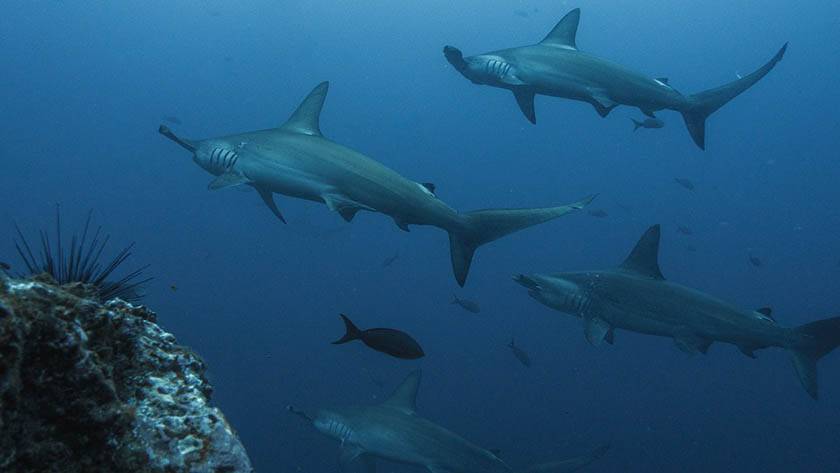- All hammerhead sharks are very thermophilic fish. They live only in tropical seas and in warm regions of the oceans. Fortunately, there are no chances to meet them in cold seas.
- Unlike most other sharks, hammerhead ones don’t live alone. They hunt alone, yes, (only at night), but during the day they gather in large flocks.
- Contrary to popular belief, there is not only one kind of hammerhead shark in the world but ten. Zoologists divide them into two genera. The largest of them is a great hammerhead shark, growing up to 18 feet (6 meters) in length, and the smallest is a scalloped bonnethead, which grows up to 2.5-3 feet (80-90 cm).
- These are viviparous fish. They don’t lay eggs but give birth to live offspring. An interesting fact about hammerhead sharks: during mating, males usually bite females, which is why those females are often covered with numerous scars, especially old specimens. Hammerhead sharks reproduce once a year or two.
- Wighead sharks are the most aggressive of all hammerhead ones. They grow up to 5 feet (1.8 meters) in length. These fish attack everyone around, including their own species, and don’t disdain cannibalism, eating the young of their own species occasionally.

- Hammerhead sharks have nearly 360 degrees of vision, thanks to the position of their eyes. Each eye is positioned at the end of the lateral head extension, which means they can see almost everything around them.
- The width of the “hammer” of a winghead shark usually reaches 40-50% of the body length, which makes it look disproportionate and even funny. This is a deceptive impression: these fish are really extremely aggressive. Fortunately, they almost never attack people.
- In the past, traditional Hawaiian culture considered sharks to be sea deities. Sometimes these fish were seen as deceased relatives after reincarnation.
- Bonnetheads, which also belong to the family of hammerhead fish, have the most negative buoyancy among all marine creatures. In other words, if they stop moving, they will sink and drown.
- All species of these predatory fish live in the near-surface layer of water, rarely diving to a depth of more than 60-90 feet (20-30 meters). However, there is documented evidence that they were also found at a depth of 750-900 feet (250-300 meters).
- Fishing nets cause great damage to the hammerhead shark population. Hammerhead sharks often get entangled in these nets and die because of the specific shape of the head.
- Great hammerhead sharks eat everyone they can defeat, they often hunt even stingrays, including dangerous stingrays (dangerous, because of the poisonous sting on the tail). Attacking stingrays, hammerheads stun them with a blow of their “hammer”.
- Great hammerhead sharks have a faster growth rate than the other hammerhead species and therefore reach maturity earlier, between 5 and 9 years old.
- Hammerhead sharks have long been boogeymen for divers, but these are just horror stories. Of course, these fish are a potential threat, but in fact, only about 20 cases of these fish attacking people have been recorded in history. We are too different from the prey they are used to hunt.
- The largest hammerhead shark ever caught weighed about 1280 pounds (580 kg) and had a length of a bit more than 18 feet (6.1 meters). But this is rather an exception since even the largest representatives of this family usually grow only up to 9-12 feet (3-4 meters) and gain weight in the range of 550-650 pounds (250-300 kg).

- Hammerhead sharks are caught in Malaysia, Thailand, India, and Pakistan. Their livers are used to make medicines.
- Hammerheads are way younger than other sharks. They most likely emerged 23-50 million years ago. Dinosaurs became extinct about 65 million years ago.
- On the leading edge of the “hammer” of hammerhead sharks are cells that help them to sense even the weakest electrical impulses that occur, for example, when some fish contracts muscles. This helps them find prey in the dark.
- Great hammerhead sharks are apex predators and can be found around the world in coastal warm waters with temperatures of 68 degrees (20 degrees Celsius) or higher. Unlike scalloped hammerhead sharks, great hammerhead sharks are solitary and migrate long distances in excess of 756 miles (1,200 km) alone.
- The “hammer” of those sharks is called “cephalofoil”. It’s responsible for the distinctive shape of the hammerhead group. It gives them super-effective binocular vision and depth perception.


